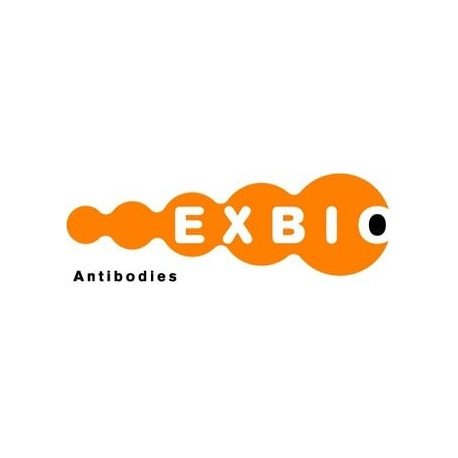Cart 0 Product Products (empty)
No products
To be determined Shipping
0,00 € Total
Prices are tax excluded
Product successfully added to your shopping cart
Quantity
Total
There are 0 items in your cart. There is 1 item in your cart.
Total products (tax excl.)
Total shipping (tax excl.) To be determined
Total (tax excl.)
Data sheet of Rabbit Polyclonal to ZAP-70
| Brand | Exbio |
| Product type | Primary antibodies |
| Reactivity | Human |
| Clonality | Polyclonal |
More info about Rabbit Polyclonal to ZAP-70
| Brand: | Exbio |
| Product no.: | 11-430-C025 |
| Product type: | Primary antibodies |
| Host species: | Rabbit |
| Product name: | Rabbit Polyclonal to ZAP-70 |
| Antigen: | ZAP-70 |
| Clonality: | Polyclonal |
| Clone: | Polyclonal |
| Immunogen: | Bacterially expressed fusion protein representing C-terminal part (160 amino acids) of human ZAP-70 with histidine tag |
| Format: | purified |
| Specificity: | The polyclonal antibody recognizes C-terminal part of human ZAP-70 protein tyrosine kinase. ZAP-70 is a molecule susceptible to degradation. It is recommended to use freshly prepared cell lysates (protease inhibitors are essential) to avoid non-specific staining of degradation products._x000D_ _x000D_ |
| Categories: | Phosphorylation (Kinases, Phosphatases, Phosphotyrosine) (Human), Phosphorylation (Kinases, Phosphatases, Phosphotyrosine) |
| Concentration: | 1 mg/ml |
| Storage buffer: | Phosphate buffered saline (PBS) with 15 mM sodium azide, approx. pH 7.4 |
| Storage / stability: | Store at 2-8°C. Do not freeze. Do not use after expiration date stamped on vial label. |
| Background: | The ZAP-70 (zeta-associated protein of 70 kDa) tyrosine kinase was identified as a tyrosine phosphoprotein that associates with TCR zeta subunit and undergoes tyrosine phosphorylation following TCR stimulation. ZAP-70 is a Syk family tyrosine kinase primarily expressed in T and NK cells that plays an essential role in signaling through the TCR. TCR-mediated activation of T cells is crucial to the immune response. In humans, ZAP-70 gene mutations resulting in lower ZAP-70 protein expression levels or expression of catalytically inactive ZAP-70 proteins, have been identified. ZAP-70 deficiency results in the absence of mature CD8+ T cells and the prevention of TCR-mediated activation of CD4+ T cells, and it can lead to severe combined immunodeficiency. ZAP-70 contains two N-terminal SH2 domains (Src homology domain 2) and a C-terminal kinase domain. During T cell activation, the binding of ZAP-70 SH2 domains to the phosphorylated zeta subunit on the activated TCR complex causes a colocalization with the Lck tyrosine kinase that phosphorylates ZAP-70 on Tyr493 in the activation loop. ZAP-70 autophosphorylates multiple tyrosines in the region between the SH2 domains and the kinase domain, including the binding sites for additional SH2-containing signaling proteins such as SLP76, LAT, Lck, PLCgamma1, Vav, Shc, Ras-GAP, and Abl. ZAP-70-mediated activation of these downstream effectors leads to the release of intracellular calcium stores, and the transcription of interleukin-2 and other genes important for an immune response. |
| Purity: | > 95% (by SDS-PAGE) |
| Purification: | Purified from rabbit serum by affinity chromatography |
| General references: | *Ishaq M, DeGray G, Natarajan V: Evidence for the involvement of tyrosine kinase ZAP 70 in nuclear retinoid_x000D_ receptor-dependent transactivation in T lymphocytes. J Biol Chem. 2005 Oct 7;280(40):34152-8._x000D_ _x000D_ , *Schneider H, Smith X, Liu H, Bismuth G, Rudd CE: CTLA-4 disrupts ZAP70 microcluster formation with reduced T cell/APC dwell times and calcium mobilization. Eur J Immunol. 2008 Jan;38(1):40-7._x000D_ _x000D_ _x000D_ , *Chan AC, Irving BA, Fraser JD, Weiss A: The zeta chain is associated with a tyrosine kinase and upon T-cell antigen receptor stimulation associates with ZAP-70, a 70-kDa tyrosine phosphoprotein. Proc Natl Acad Sci USA 88(20), 9166 (1991)._x000D_ |
| Related products: | - Rat Monoclonal to CD11b (mouse) / Mac-1 alpha - Rat Monoclonal to CD105 (mouse) - Rat Monoclonal to CD11a (mouse) / LFA-1 alpha chain |
| Shipping condition: | Room temperature |


